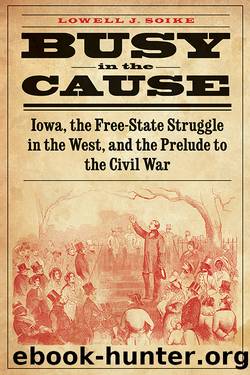Busy in the Cause by Lowell J. Soike

Author:Lowell J. Soike [Lowell J. Soike]
Language: eng
Format: epub
Tags: History
ISBN: 9780803271890
Publisher: University of Nebraska Press
Published: 2014-03-25T15:07:26+00:00
Fig. 17. Jeremiah G. Anderson went from Yellow Springs, Iowa, to the Kansas Territory and participated in antislavery efforts there. He joined John Brown in his Harpers Ferry raid and died in the effort. Kansas State Historical Society.
Others, however, Kagi could not find or they failed to reply or simply did not turn up. Richard Richardson, the runaway who stayed the winter at Springdale and went with them to Chatham in April 1858, was evidently âaway harvesting.â In 1858 Richard Realf had returned to England. Then Kagi learned he was back in America but did not know his whereabouts (Realf had gone first to New Orleans and then to Tyler, Texas, during this period). Leonhardt, a military-trained Polish fugitive from the 1848 revolution and immigrant to Kansas, had been an antislavery partisan and a friend of Brownâs. But he did not answer Kagiâs or Brownâs letters sent to him in Cincinnati, where he was a law student.84
Two antislavery comrades declined because their current lives now outweighed the companionship they had enjoyed the year before. Charles Moffett of Montour, Iowa, and Luke Parsons of Byron, Illinois, had both been Kansas guerrilla fighters, had participated in the winter drill at Maxsonâs place in Springdale, and had attended the Chatham Convention. They had found odd jobs as they drifted back home. Gradually they lost faith in, or their zeal for, the movement although they continued to be highly interested in what âthe boysâ were doing.85 Moffett replied to Kagiâs letter that present âdifficulties in the wayâ would prevent him from coming âtho I feel as deap an interest for the caus as ever and hope yet to do more for it than I hav.â When Parsons found out during the summer of 1858 that âBrown, Kagi, Stevens and Tidd were in Kansas keeping up the racket,â he had sent off a testy letter to Brown and asked âwhy he took care of part of the crowd and left the rest of us to shift for ourselves.â Brown replied, âYou have a good trade and can take care of yourself anywhere; Kagi is supporting himself by his pen, as to Stevens and Tidd, they had to be cared for. Hope you will keep in correspondence with the rest of the boys. Think all will be well in the spring.â Unsatisfied, Parsons later admitted, âI was mad and did not reply.â86
Instead, during that winter Luke Parsons and four others got together oxen and a covered wagon to head west in the spring of 1859. Without money, still peeved at not having heard from Brown or Kagi, and putting up with home complaints to pay a $230 debt he owed, he and the others left Illinois for the Pikes Peak gold fields. âWhen at Council Bluffs waiting for grass to grow on the plains,â recalled Parsons, âI got letters from Brown and Kagi saying they had been to my home in Byron, âthat I must surely turn back, sure go, we depend on you, etc., etc.ââ
Download
This site does not store any files on its server. We only index and link to content provided by other sites. Please contact the content providers to delete copyright contents if any and email us, we'll remove relevant links or contents immediately.
| United States | Abolition |
| Campaigns & Battlefields | Confederacy |
| Naval Operations | Regimental Histories |
| Women |
In Cold Blood by Truman Capote(3311)
The Innovators: How a Group of Hackers, Geniuses, and Geeks Created the Digital Revolution by Walter Isaacson(2845)
Steve Jobs by Walter Isaacson(2836)
All the President's Men by Carl Bernstein & Bob Woodward(2328)
Lonely Planet New York City by Lonely Planet(2172)
And the Band Played On by Randy Shilts(2131)
The Room Where It Happened by John Bolton;(2104)
The Poisoner's Handbook by Deborah Blum(2093)
The Murder of Marilyn Monroe by Jay Margolis(2059)
The Innovators by Walter Isaacson(2056)
Lincoln by David Herbert Donald(1945)
A Colony in a Nation by Chris Hayes(1881)
Under the Banner of Heaven: A Story of Violent Faith by Jon Krakauer(1750)
Amelia Earhart by Doris L. Rich(1650)
The Unsettlers by Mark Sundeen(1647)
Being George Washington by Beck Glenn(1622)
Birdmen by Lawrence Goldstone(1621)
Dirt by Bill Buford(1612)
Zeitoun by Dave Eggers(1593)
